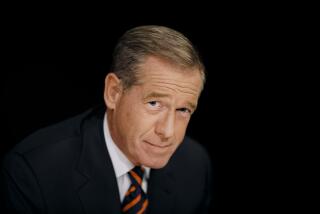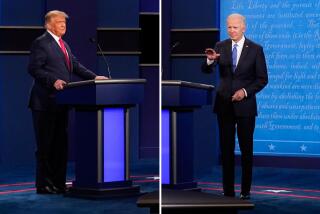The joy’s on the bus for news crews
- Share via
MANCHESTER, N.H. — In the not-so-distant past of campaign coverage, network news correspondents would vie for a prime place on a candidate’s travel bus. This political year, ABC and CNN want it the other way around, as they compete to get the candidates to come visit their own hard-to-miss buses parked outside campaign events.
Buses and campaign coverage have been inextricably linked in the public mind since Tim Crouse examined early attempts at political spin doctoring in “The Boys on the Bus,” his book on the 1972 presidential contest.
But this is an era when the news business is infatuated with the latest technology and can’t afford to ignore promotional opportunities. So ABC and CNN are taking every opportunity to draw attention to their respective campaign buses that are equipped with mobile technology, some of which was first tried out last year during the Iraq war.
Not everyone’s impressed. In the fall, when CNN announced its “Election Express” and ABC unveiled its three buses, other networks sniffed, calling them nothing more than gimmicky marketing vehicles. There’s still some grumbling by rivals, but others are more impressed by the rolling self-contained work units, control room/TV studio/editing stations in which interviews can be taped while rumbling along. “NBC Nightly News” anchor Tom Brokaw calls them a “pretty good idea.”
ABC “Good Morning America” national correspondent Claire Shipman is a convert. What seemed at first nothing more than a good visual prop, she says, has turned out to be a valuable mobile workstation. Monday morning, she sat in the crowded back quarters of one ABC bus parked outside Manchester City Hall, writing out remarks before jumping outside to do a live report, then ducking back inside to escape near-zero temperatures. Without the bus, there would have been a much longer wait in the cold, and no Internet access or editing facilities to use between the live shots.
While Shipman is outside in the dawn, colleague George Stephanopoulos, anchor of “This Week,” is inside, doing his own live stand-up report. There’s a tiny glitch, a five-second delay that makes it hard for him to hear Charlie Gibson in New York, but he isn’t complaining. After three weeks on the bus, criss-crossing Iowa and New Hampshire, he raves about how the buses have let him spend more time with the candidates, who can often be convinced to do a quick interview on a ride between events, with their staffs -- and other journalists -- following along behind.
CNN correspondent Bob Franken said he likes that the “old-fashioned bus takes advantage of the new technology” and helps him get further away from headquarters and into the field.
For competitive news organizations seeking any little edge in the crowded media universe, being able to shut out the crush of rivals is a plus. At one event, “The other reporters were just milling around us,” while Sen. Joe Lieberman (D-Conn.) was ensconced inside doing an interview, CNN producer Eileen McMenamin said.
And instead of taking into account the lengthy set-up times TV news crews usually need for all of their bulky equipment, Stephanopoulos says, when the bus pulls up he can tell a candidate, “It’s going to take only 10 minutes, I promise.”
“It makes it harder for the candidates to say no,” Shipman says, and it has meant more face-to-face interviews.
The buses also have been cost savers, eliminating loads of equipment, the wires, lights and “technical doodads that you really need to do television,” says Leo Meidlinger, a senior producer in ABC’s Washington bureau. And they have served that all-important public relations purpose, too, with fans sometimes clustering outside. ABC has used its bus to get out of the media hubs and hear what citizens are saying in towns the bus is passing through. “The bus forces us to drive through towns and cities we wouldn’t have before,” says David Reiter, a senior producer.
Both ABC and CNN are using fine-tuned technology that got its first real workout in the Iraq war, including mobile digital-editing stations. In ABC’s case, the equipment came back from Iraq and went immediately into the buses, which are converted tour buses used in the past by Justin Timberlake, LeAnn Rimes and Cher. CNN’s bus was previously used by Hank Williams Jr.
Rivals without the fancy buses question whether the novelty will soon wear off. ABC and CNN are more focused on a friendly rivalry about whose bus is better, and in particular whether it’s better to have a bathroom or not; CNN does, ABC doesn’t. “I’m glad we don’t,” Stephanopoulos says, adding, in reference to the cleanliness factor in such close quarters, “Can you imagine?”
More to Read
The biggest entertainment stories
Get our big stories about Hollywood, film, television, music, arts, culture and more right in your inbox as soon as they publish.
You may occasionally receive promotional content from the Los Angeles Times.










